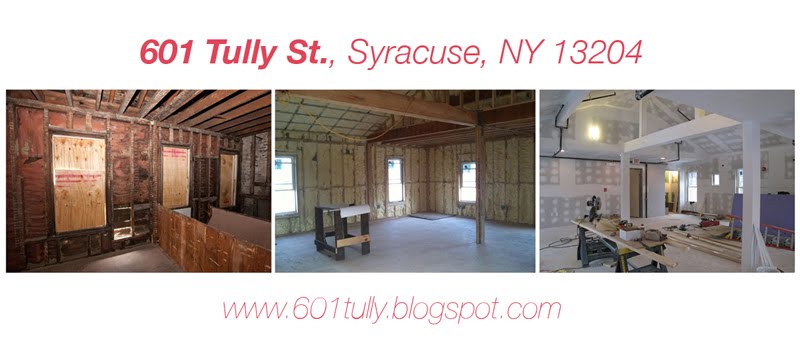About 601 Tully
Check out our new website! 601Tully.syr.edu
601 Tully is a center for engaged practice in Syracuse, NY developed by artist and professor Marion Wilson with a rotating collaborative team of 54 students and neighbors and Anda French of French 2Design. It's a site for meaningful exchange between artists, community members, and scholars in the co-production of culture.
601 Tully includes a contemporary art space, a public events space, a bookstore, a teaching garden, and Recess Cafe West.
In 2009, Wilson purchased the condemned two-story home and local drug hub, and throughout five semesters, Wilson's design/build class re-zoned, designed, renovated and now sustains the physical and programmatic aspects of 601 Tully. The collaborative team has consisted of artists, architects, environmentalists, Fowler High School students, Green Train Workforce, neighbors, and the occasional passerby.
601 Tully is made possible by the generous support of the Syracuse University School of Education, The Kauffman Foundation, The Near West Side Initiative, Imagining America, Home HeadQuarters Inc., Say Yes to Education, and National Grid.
Find us on Facebook!
Thursday, December 9, 2010
Foot Stools and Invented Communities
I agree with Miwon Kwon's criticism of contemporary artists' notion of communities. Just as Susan Lacy's piece Full Circle epitomized a “community of mythic unity,” the entire Near West Side Initiative is in danger of making assumptions about the imagined communities it serves. If we assume a loose conglomeration of low-income residents in need of our benevolence we would indeed create a community of “mythic unity” whose response to our efforts would be just as haphazard as the effort itself. If on the other hand we identify a community by its geographical location (the Near West Side) or by a previously established one (the Boys and Girls Club for instance) we run the risk of misunderstanding the original nature of the community. At best we might only impose our own predetermined agenda on the community of choice, thus committing the blunder of what Kwon calls “Site Community.” But 601 Tully is different from both Full Circle and We Got It from Art Chicago because it relies on a long term development of purpose that coincides with the development of a community. In this way 601 falls into Kwon's fourth category, “Invented Communities.” Far from a blunder, I consider this to be 601's strength. In its attempts to help a community, 601 is in fact creating a community. This in turn may be far more helpful to those who need help than an art project would be to a pre-existing community.
I do not believe that one's role should be defined by one's title, but rather one's title should reflect his role. As 601 has not yet fully realized its role in the community it is constructing, I find it fitting that the creators have so much trouble categorizing the project and describing the function of the building. Is it a gallery, cafe, classroom, storefront, or community center? The answer to this question will only be revealed when the community that uses it is fully realized. The important thing is that 601 Tully will crate a support system and infrastructure that allows others to build their own apparatuses, systems, and community. Perhaps it will less a community center and more a site where community is forged. A community lab if you will. Once again, the emphasis is on the system rather than an individual piece. A foot stool, when designed well, can serve any number of functions that the user is capable of devising. A finely carved, ornate, high-backed chair on the other hand, can only be sat in. Let us hope that 601 be more like the stool, and less like a high-backed chair.

Are we not in fact still imposing our predetermined agenda on the community?
ReplyDeleteI agree that 601 should be more of a foot stool, I worry though that it might turn into one that's at an awkward height and you don't know what to do with it. It's important to give those people that will use 601 Tully the opportunity to plug their own needs of program into it (to become a community lab, as you said). But are we imposing a structure that will not receive this well?